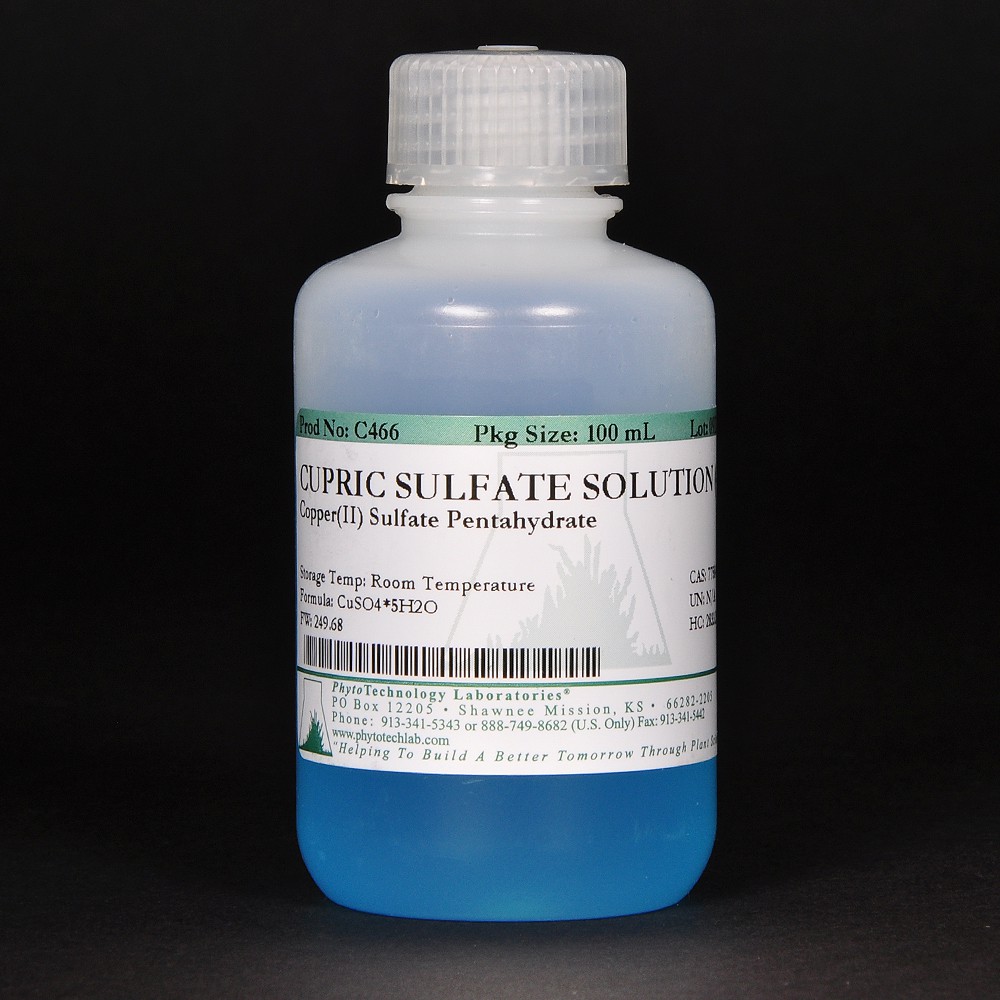Introduction
Description: Copper (II) Sulfate is used as a copper source in the bicinchonic acid assay for protein
| Grade |
ACS Reagent |
| Miscibility |
Water |
| Physical Form |
Liquid |
| Sterility |
Sterile Filtered |
| Storage Temp. |
Room Temperature |
| UPC/SKU |
C466 |
| CAS NUMBER |
7758-99-8 |
| Formula Weight |
249.68 |
| Formula |
CuSO45H2O |
| Manufactured from |
C375 |
| Storage Temp. |
Room Temperature |
| Tariff Code |
2833.25.0000 |
| Risk Info (R) |
50/53 |
| Safety Info (S) |
61 |
No information available
C466 Copper (II) Sulfate Solution (4%)
| Synonyms: |
Copper(II) Sulfate Pentahydrate; Cupric Sulfate |
| CAS: |
7758-99-8 |
| Formula: |
CuSO4•5H2O |
| Mol. Weight: |
249.68 |
| Properties |
|---|
| Form: |
Liquid |
| Appearance: |
Blue, Clear |
| Application: |
Plant Micronutrient, Fungicide, Herbicide, Algicide |
| Solubility: |
Miscible with Water |
| Storage Temp: |
Room Temperature |
| Other Notes: |
Plant Tissue Culture Tested |
Application Notes
Used as a micronutrient in plant tissue culture. Can also be used as a fungicide, although some fungi are capable of persisting through elevated levels of copper ions (Johnson, 1935). As an herbicide, it can be used to control the growth of aquatic plants, as well as algae (Newbold, 1975; Robson et al, 1976). It also inhibits the growth of bacteria, such as Escherichia coli (Tetaz & Luke, 1983).
It is used in Fehling’s Solution and Benedict’s Solution to test for reducing sugars. Reducing sugars will cause the blue color of the copper in solution to change to an insoluble red solution of copper(I) oxide. Can also be used in the Biuret reagent to test for proteins.
References
Merck 13, 2682 Gadd, G. M., & Griffiths, A. J. (1977). Microorganisms and heavy metal toxicity. Microbial Ecology, 4(4), 303-317.
Johnson, GF (1935) "The Early History of Copper Fungicides". Agricultural History 9(2): 67–79. Le Jeune, A. H., Charpin, M., Deluchat, V., Briand, J. F., Lenain, J. F., Baudu, M., & Amblard, C. (2006). Effect of copper sulphate treatment on natural phytoplanktonic communities. Aquatic toxicology, 80(3), 267-280.
Newbold, C (1975) Herbicides in aquatic systems. Biological Conservation 7(2):97-118. Robson, T. O., Fowler, M. C., & Barrett, P. R. (1976). Effect of some herbicides on freshwater algae. Pesticide Science, 7(4), 391-402.
Sadler, W. R., & Trudinger, P. A. (1967). The inhibition of microorganisms by heavy metals. Mineralium Deposita, 2(3), 158-168.
Tetaz, T. J., & Luke, R. K. (1983). Plasmid-controlled resistance to copper in Escherichia coli. Journal of bacteriology, 154(3), 1263-1268




